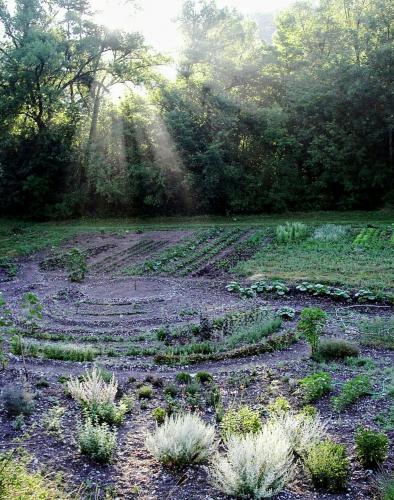
Diary herbalist. Summer in the French Drôme.
2009. Summer in the French Drôme.
The heat and the drought may be good for the tourist, but for my garden, it's a big misery. Watering from the stream remains the only way to keep the plants alive. And I who are accustomed in Belgium even in the summer, to take plants out of the soil, to tear and to replant them. I try it here, but then I have to plant them in humus rich soil separately in pots and in the shade and, of course, water them every day. Even better is to cover the plants in the first days. And then it wants to work.
Today I try to propagate motherwort and yellow chamomile, these sturdy perennials can take a beating. Thick pollen I just divide into 4 pieces, cracks are called in garden steel. It is the right word for this aggressive act at first sight, the torn plants may be in shock for a while but with a loving care they come out stronger. Sow in compost
I want to sow some further, but the soil is hard and cracked. A few days ago, I threw some wheelbarrows compost on it and a bag of herbier du Diois herbal waste. Then I watered abundantly and covered the piece of land with cardboard. Permaculture might call that.Today I have sown in one curved line lettuce, radishes and green beans in that compost. On that piece of soil have previously stood poppies, the ripe seed from those Sleeping Bulbs will germinate with it. As far as I'm concerned, the more the better.
What is Herbier du Diois's herbal waste?
Large bags of spices and herbs from all over the world are cleaned at the Herbier spice wholesaler in Chatillon and Diois, cleaned of stones, dust and residues of other plants. I can use this very aromatic waste in the garden as a ground cover or as a compost and that is a special pleasure and a blessing to be able to fertilize a herb garden and to additionally aromatize it with spices and other herbs.Many plants I have to plant in the heavy and dry soil of Bellegarde in containers for sowing. At the beginning of July I sowed Leuzea carthamoids and shrub basil, which are now well germinated 3 weeks later. I transplanted a few Leuzeas into pots today. A test! If I can do it, I can transplant the rest next week. But in the open ground, it's good here in September or early spring.
Feverwort and maralroot
Fevery or Tanacetum parthenium is a short-lived perennial closely related to our tansy. This feederwort has been the plant for several years against migraines and headaches.Leuzea carthamoids or Maralroot, a sturdy perennial with artichoke flower, is used as an adaptogen with an anabolic, muscle strengthening effect.
Harvesting and butterflies
We can, of course, harvest some at the end of July. We pick lavender flowers to make lavender torches, beautiful green seed boxes for dry bouquets and wormwood tops for smudge sticks. I'm photographing an abundance of butterflies on my lavender bushes. Emperor's mantle, royal age, lemon butterfly, even the spurge tail is part of the party and of course the omnipresent red St. John's butterfly. They flutter happily even if they only live one day.If you live under a linden tree like us, you see them in excess. The small, black-red drawn bugs, which seem to be constantly copulating. Are they traveling forever? These cozy critters feed mainly on the fruits (seeds) of the linden. If I picked all my linden blossom, they'd probably disappear. But who still picks linden in linden land?
Pierre
Fortunately, our French village is not only populated with plants and insects but also with people. Strangers like me but luckily also some native residents. Although they're starting to be rare. Pierre, the original inhabitant of Bellegarde, sometimes sits on the old stone under the old linden to be 85 years old. You can't sow eternity, he says, in French, of course. Something of “l'éternité, on ne semence pas.” I, 65 years of hopping young, give eternal water to pots and pans with lemon verbena, fig tree, motherwort and holy flower. Is eternity for another life? Does a plant give water to my roots?#dagboek #2009 #tuin #tuinieren
- Comments (0)
- Recommended
- Milestones

Here are your recommended items...
Here are your milestones...




